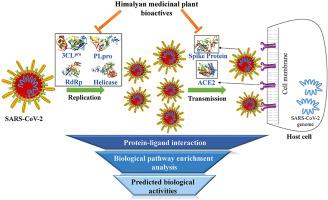Computers in Biology and Medicine ( IF 7.7 ) Pub Date : 2021-04-20 , DOI: 10.1016/j.compbiomed.2021.104383 Jagadish Natesh 1 , Priya Mondal 1 , Bhavjot Kaur 2 , Abdul Ajees Abdul Salam 3 , Srikaa Kasilingam 2 , Syed Musthapa Meeran 1

|
Background
Identification and repurposing of therapeutic and preventive strategies against COVID-19 are rapidly undergoing. Several medicinal plants from the Himalayan region have been traditionally used to treat various human disorders. Thus, in our current study, we intend to explore the potential ability of Himalayan medicinal plant (HMP) bioactives against COVID-19 using computational investigation.
Methods
Molecular docking was performed against six crucial targets involved in the replication and transmission of SARS-CoV-2. About forty-two HMP bioactives were analyzed against these targets for their binding energy, molecular interactions, inhibition constant, and biological pathway enrichment analysis. Pharmacological properties and potential biological functions of HMP bioactives were predicted using the ADMETlab and PASS webserver respectively.
Results
Our current investigation has demonstrated that the bioactives of HMPs potentially act against COVID-19. Docking results showed that several HMP bioactives had a superior binding affinity with SARS-CoV-2 essential targets like 3CLpro, PLpro, RdRp, helicase, spike protein, and human ACE2. Based on the binding energies, several bioactives were selected and analyzed for pathway enrichment studies. We have found that selected HMP bioactives may have a role in regulating immune and apoptotic pathways. Furthermore, these selected HMP bioactives have shown lower toxicity with pleiotropic biological activities, including anti-viral activities in predicting activity spectra for substances.
Conclusions
Current study results can explore the possibility of HMPs as therapeutic agents against COVID-19.
中文翻译:

通过计算研究,传统喜马拉雅药用植物的植物化学物质有望对抗 SARS-CoV-2 的假定复制和传播目标
背景
针对 COVID-19 的治疗和预防策略的识别和再利用正在迅速进行。喜马拉雅地区的几种药用植物传统上被用于治疗各种人类疾病。因此,在我们目前的研究中,我们打算通过计算研究探索喜马拉雅药用植物 (HMP) 生物活性物质对抗 COVID-19 的潜在能力。
方法
针对参与 SARS-CoV-2 复制和传播的六个关键目标进行了分子对接。针对这些靶标分析了大约 42 种 HMP 生物活性物质的结合能、分子相互作用、抑制常数和生物途径富集分析。分别使用 ADMETlab 和 PASS 网络服务器预测 HMP 生物活性物质的药理特性和潜在生物学功能。
结果
我们目前的调查表明,HMP 的生物活性可能对抗 COVID-19。对接结果表明,几种 HMP 生物活性物质与 SARS-CoV-2 重要靶标如 3CL pro、PLpro、RdRp、解旋酶、刺突蛋白和人 ACE2 具有优异的结合亲和力。基于结合能,选择并分析了几种生物活性物质用于途径富集研究。我们发现选定的 HMP 生物活性物质可能在调节免疫和凋亡途径中发挥作用。此外,这些选定的 HMP 生物活性物质在多效生物活性方面表现出较低的毒性,包括预测物质活性谱的抗病毒活性。
结论
目前的研究结果可以探索 HMP 作为 COVID-19 治疗剂的可能性。


























 京公网安备 11010802027423号
京公网安备 11010802027423号